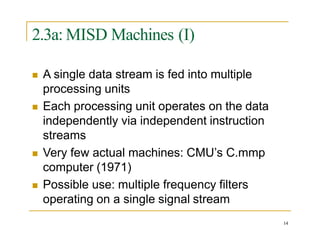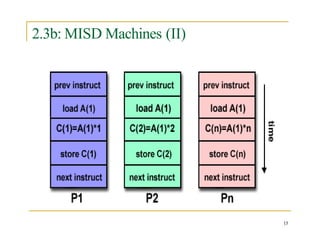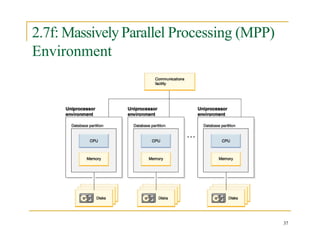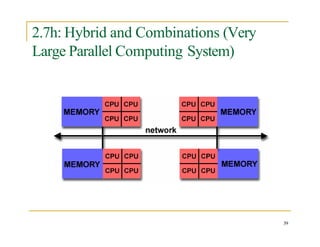Lecture 04 chapter 2 - Parallel Programming Platforms
- 1. Parallel and Distributed Computing Chapter 2: Parallel Programming Platforms 1 Muhammad Haroon [email protected] Cell# +92300-7327761 Department of Computer Science Hitec University Taxila Cantt Pakistan
- 2. 2.1a: Flynn’s Classical Taxonomy 2 One of the more widely used parallel computer classifications, since 1966, is called Flynn’s Taxonomy It distinguishes multiprocessor computers according to the dimensions of Instruction and Data SISD: Single instruction stream, Single data stream SIMD: Single instruction stream, Multiple data streams MISD: Multiple instruction streams, Single data stream MIMD: Multiple instruction streams, Multiple data streams
- 3. 2.1b: SISD Machines A serial (non-parallel) computer Single instruction: Only one instruction stream is acted on by CPU during any one clock cycle Single data: Only one data stream is used as input during any one clock cycle Deterministic execution Oldest and most prevalent form computer Examples: Most PCs, single CPU workstations and mainframes 3
- 4. 2.2a: SIMD Machines (I) 4 A type of parallel computers Single instruction: All processor units execute the same instruction at any give clock cycle Multiple data: Each processing unit can operate on a different data element It typically has an instruction dispatcher, a very high-bandwidth internal network, and a very large array of very small-capacity instruction units Best suitable for specialized problems characterized by a high degree of regularity, e.g., image processing Two varieties: Processor Arrays and Vector Pipelines Examples: Connection Machines, MasPar-1, MasPar-2; IBM 9000, Cray C90, Fujitsu VP, etc
- 5. 2.2b: SIMD Machines (II) 5
- 6. 2.2c: SIMD Machine (III) 6
- 8. Pipelined Processing A pipeline, also known as a data pipeline, is a set of data processing elements connected in series, where the output of one element is the input of the next one. The elements of a pipeline are often executed in parallel or in time-sliced fashion A category of techniques that provide simultaneous, or parallel, processing within the computer. It refers to overlapping operations by moving data or instructions into a conceptual pipe with all stages of the pipe processing simultaneously. 8
- 9. 2.2f: Pipelined Processing A six-step pipeline with IEEE arithmetic hardware Parallelization happens behind the scene Not true parallel computers 9
- 10. Assembly Line An assembly line is a manufacturing process in which parts are added as the semi-finished assembly moves from workstation to workstation where the parts are added in sequence until the final assembly is produced 10
- 12. Vector Processor Pipeline The term "vector pipeline" was used in the 1970's to describe vector processing at a time when a single vector instruction might (for example) compute the sum of two vectors of floating point numbers using a single pipelined floating point arithmetic unit 12
- 13. 2.2h: Vector Processor Pipeline 13
- 14. 2.3a: MISD Machines (I) 14 A single data stream is fed into multiple processing units Each processing unit operates on the data independently via independent instruction streams Very few actual machines: CMU’s C.mmp computer (1971) Possible use: multiple frequency filters operating on a single signal stream
- 15. 2.3b: MISD Machines (II) 15
- 16. 2.4a: MIMD Machines (I) 16 Multiple instruction: Every processor may execute a different instruction stream Multiple data: Every processor may work with a different data stream Execution can be synchronous or asynchronous, deterministic or non- deterministic Examples: most current supercomputers, grids, networked parallel computers, multiprocessor SMP computer
- 17. 2.4b: MIMD Machines (II) 17
- 18. 2.4c: MIMD Machines (III) 18
- 19. T3E-Cray 19 The Cray T3E was Cray Research's second-generation massively parallel supercomputer architecture, launched in late November 1995. ... Like the previous Cray T3D, it was a fully distributed memory machine using a 3D torus topology interconnection network.
- 20. 2.4d: MIMD Machines (T3E-Cray) 20
- 21. 2.5: Shared Memory and Message Passing 21 Parallel computers can also be classified according to memory access Shared memory computers Message-passing (distributed memory) computers Multi-processor computers Multi-computers Clusters Grids
- 22. 2.6a: Shared Memory Computers 22 All processors have access to all memory as a global address space Multiple processors can operate independently, but share the same memory resources Changes in a memory location effected by one processor are visible to all other processors Two classes of shared memory machines: UMA and NUMA, (and COMA)
- 23. 2.6b: Shared Memory Architecture 23
- 24. 2.6c: Uniform Memory Access (UMA) 24 Most commonly represented today by Symmetric Multiprocessor (SMP) machines Identical processors Equal access and access time to memory Sometimes called CC-UMA – Cache Coherent UMA Cache Coherence: If one processor updates a location in shared memory, all the other processors know about the update. Cache coherence is accomplished at the hardware level
- 25. 2.6d: Symmetric Multiprocessor (SMP) 25
- 26. 2.6e: UMA –with and without caches 26
- 27. 2.6f: Nonuniform Memory Access (NUMA) 27 Often made by physically linked two or more SMPs One SMP can directly access memory of another SMP Not all processors have equal access time to all memories Memory access across link is slower If cache coherence is maintained, they may also be called CC-NUMA
- 28. 2.6g: NUMA 28
- 29. 2.6h: Hybrid Machine (UMA & NUMA) 29
- 30. 2.6i: Advantages of Shared Memory Machines 30 Global address space provides a user-friendly programming environment to memory access Data sharing between tasks is both fast and uniform due to proximity of memory to CPUs
- 31. 2.6j: Disadvantages of Shared Memory Machines 31 Lack of scalability between memory and CPUs: Adding processors can geometrically increase traffic on the shared memory-CPU path and for cache coherence management Programmer’s responsibility for synchronization constructs (correct access to memory) Expensive to design shared memory computers with increasing numbers of processors
- 32. 2.7a: Distributed Memory Computers 32 Processors have their own local memory It requires a communication network to connect inter-processor memory Memory addresses in one processor do not map to another processor – no concept of global address space across all processors The concept of cache coherence does not apply Data are exchanged explicitly through message- passing Synchronization between tasks is the programmer’s responsibility
- 33. 2.7b: Distributed Memory Architecture 33
- 34. 2.7c: Advantages of Distributed Memory Machines 34 Memory is scalable with the number of processors Increase the number of processors, the size of memory increases proportionally Each processor can rapidly access its own memory without interference and without the overhead incurred with trying to maintain cache coherence Cost effectiveness: can use commodity, off-the- shelf processors and networking
- 35. 2.7d: Disadvantages of Distributed Memory Machines 35 Difficult to program: Programmer has to handle data communication between processors Nonuniform memory access (NUMA) times It may be difficult to map existing data structures, based on global memory, to distributed memory organization
- 36. 2.7e: Networked Cluster of Workstatsions (PCs) 36
- 37. 2.7f: Massively Parallel Processing (MPP) Environment 37
- 38. 2.7g: Distributed Shared Memory (DSM) Computer 38
- 39. 2.7h: Hybrid and Combinations (Very Large Parallel Computing System) 39
- 40. 2.8: Architectural Design Tradeoffs 40 Shared memory Distributed memory Programmability easier harder Scalability harder easier
- 41. 2.9:Parallel Architectural Issues 41 Control mechanism: SIMD vs MIMD Operation: synchronous vs asynchronous Memory organization: private vs shared Address space: local vs global Memory access: uniform vs nonuniform Granularity: power of individual processors coarse grained system vs fine grained system Interconnection network topology
- 42. 2.10a: Beowulf Cluster System 42 A cluster of tightly coupled PC’s for distributed parallel computation Moderate size: normally 16 to 32 PC’s Promise of good price/performance ratio Use of commodity-of-the-self (COTS) components (PCs, Linux, MPI) Initiated at NASA (Center of Excellence in Space Data and Information Sciences) in 1994 using 16 DX4 processors http://www.beowulf.org
- 43. 2.10b: NASA 128-Processor Beowulf Cluster 43
- 44. 2.11a: Sun Enterprise 10000 Server (I) 44 Starfire is a shared-address space machine 4 to 64 processors, each is an UltraSPARC II running at 400 MHz with a peak rate 800 MHz System board has up to 4 CPUs and 4GB RAM local memory Up to 64 GB memory in total 16 such boards can be connected via a Gigaplane- XB interconnect
- 45. 2.11b: Sun Enterprise 10000 Server (II) 45 Intra- and inter-board connectivity uses different interconnection networks Intra-board connectivity is by a split transaction system bus (Gigaplane bus) Global data router is a 16X16 non-blocking crossbar for the data buses and four global address buses http://www.sun.com/servers/highend/e10000/
- 46. 2.11c: Sun Enterprise 10000 Server (III) 46
- 47. 2.11d: Sun Enterprise 10000 Server (IV) 47
- 48. 2.12a: SGI Origin Servers (I) 48 SGI Origin 3000 Servers support up to 512 MPIS 14000 processors in a NUMA cache coherent shared-address-space configuration Each processor operates at 500 MHz with a peak rate of 1.0 gigaflops Modular framework with 4 CPUs and 8GB of RAM (C-Brick) Interconnection by crossbar between C- Bricks and R-Bricks (routers)
- 49. 2.12b: SGI Origin Servers (II) 49 Larger configuration are built by connecting multiple C-Bricks via R-Bricks using 6-port or 8-port crossbar switches and metarouters with full-duplex links operating at 1.6GB/s http://www.sgi.com/products/servers/origin/30 00/overview.html
- 50. 2.12c: C-Brick and R-Brick C- Brick 50 R- Brick
- 51. 2.12d: SGI Origin Server 51
- 52. 2.12e: SGI Origin Server Machine 52
- 53. 2.13a: Cray T3E/1350 53 Use Alpha 21164A processor with 4-way superscalar architecture, 2 floating point instruction per cycle CPU clock 675 MHz, with peak rating 1.35 Gigaflops, 512 MB local memory Parallel systems with 40 to 2176 processors (with modules of 8 CPUs each) 3D torus interconnect with a single processor per node Each node contains a router and has a processor interface and six full-duplex link (one for each direction of the cube)
- 54. 2.13b: Cray T3E Topology 54
- 55. 2.13c: Cray T3E Machine 55
- 56. 2.14a: UK HP Superdome Cluster 56 4 HP superdomes 256 total processors (64 processors per host/node) Itanium-2 processor at 1.6 TF peak rate 2 GB memory per processor 7 Terabytes of total disk space High speed, low latency Infiniband internal interconnect
- 57. 2.14b: HP Superdome Cluster 57
- 58. 2.15a: The Earth Simulator (I) 58 Each processor of the Earth Simulator runs at 2ns per cycle, with 16GB shared memory Total number of processors is 5,120. The aggregated peak performance is 40 TFlops with 10 TB memory It has a single stage crossbar (1800 miles of cable), 83,000 copper cables, 16 GB/s cross station bandwidth 700 TB disk space and 1.6PB mass storage
- 59. 2.15b: The Earth Simulator (II) 59 One node = 8 vector processors with a peak performance of 8G Flops (640X8 = 5,120) Area of the computer = 4 tennis courts, 3 floors Sum of all the US Department supercomputers = 24 TFlops/s in 2002 Number 1 in 2002 top 500 list (five consecutive lists) http://www.es.jamstec.go.jp/esc/eng/
- 60. 2.15c: The Earth Simulator Machine (I) 60
- 61. 2.15d: The Earth Simulator Machine (II) 61
- 62. 2.16a: IBM Blue Gene (I) 62 In December 1999, IBM Research announced a 5-year $100M project, named Blue Gene, to develop a petaflop computer for research in computational biology Proposed architecture: SMASH (simple, multiple, self-healing) Collaboration between IBM Thomas J. Watson Research Center, Lawrence Livermore National Laboratory, US DOE and academia
- 63. 2.16b: IBM Blue Gene (II) 63 1 million CPUs of 1 gigflop each = 1 petaflop 32 CPUs on a single chip, 16 MB memory 64 chips are placed on a board of 20 inches 8 boards form a tower, and 64 towers are connected into a 8X8 grid to form Blue Gene Blue Gene/L, Blue Gene/C, and Blue Gene/P for different applications # 1 and # 2 on top 500 list in December 2005 http://domino.research.ibm.com/comm/research_pro jects.nsf/pages/bluegene.index.html
- 64. 2.17a: Current Number 1 (Blue Gene/L) 64 eServer Blue Gene Solution (Blue Gene/L) 32,768 GB memory Installed in 2005 DOE/NNSA/LLNL 131,072 processors Peak performance 367.8 TFlops, 280.6 Tflops/s LINPACK benchmark See more at http://www.top500.org The Earth Simulator is currently # 10 Next round announcement: November 2006, Tampa, Florida at Supercomputing 2006
- 65. 2.17b: Blue Gene/L Picture 65
- 66. 2.18a: The Really Fastest One 66 On June 26, 2006, MD-Grape-3 at Riken in Japan, clocked at 1.0 petaflop. But it does not run LINPACK and not qualify for top 500 list Special purpose system for molecular dynamics – 3 times faster than Blue Gene/L 201 units of 24 custom MDGrape-3 chips (4808 total), plus 64 servers each with 256 Dual-Core Intel Xeon processor, and 37 servers each containing 74 Intel 3.2 GHz Xeon processors http://www.primidi.com/2004/09/01.html
- 68. 2.18c: One Board with 12 MDGrape-3 Chips 68













































































































































![GEOGRAPHY-Study Material [ Class 10th] .pdf](https://cdn.slidesharecdn.com/ss_thumbnails/geography-studymaterial-250613053858-319e1b53-thumbnail.jpg?width=560&fit=bounds)










